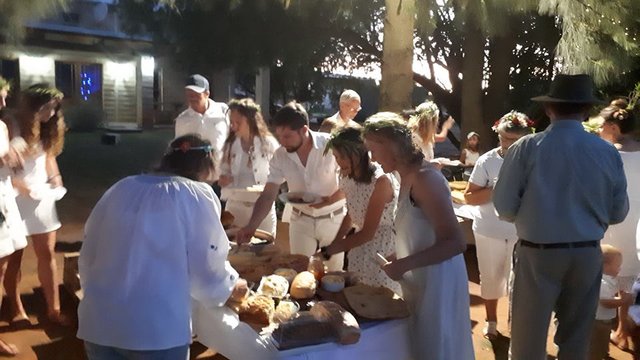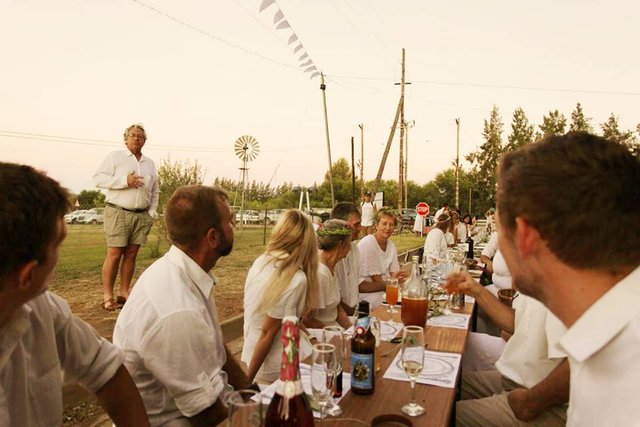This article is about the volksvreemde feast and parade that took place on 8 December 2018, Orania volkstaat.
Oom Oubaas (a strange name for the current South African scheme of things) a character of 7de Laan, an Afrikaans soap on SABC 2, always said he didn’t like “volksvreemde” – or culturally strange/outlandish - things, in other words things that are not traditional to his specifically Afrikaner culture, this despite Oom Oubaas participating fully in the kaleidoscope of often strange multi-cultural things that happen in the soap and represent the new, more inclusive and multi-cultural South African societal landscape. These occurrences the often confound him with a look of amazement and then in the end often condoning the event or thing, even though it might be reluctantly at first. A perfect example of a character not only portraying his generation of Afrikaners that have to accept the new multi-cultural, multi-lingual, equalitarian dispensation of South Africa, so different to their previous Afrikaner Nationalistic and Calvinistic background, but also a character used to help the thousands of Afrikaners religiously watching the show to accept things that were culturally unacceptable before.
The strange Boshoff family experiment in the form of Orania (as opposed to the Verwoerd family experiment in the form of Kleinfontein, near Cullinan) seeks to create a homeland (the “volkstaat” – a now dreaded term for them and for AfriForum/Solidariteit) for the Afrikaner; create a culturally safe haven for the Afrikaner; talk on behalf of the Afrikaner community at large and remold the Afrikaners into the 3rd Afrikaner. This last idea is espoused by Carel Boshoff, the current head of the Orania Movement and is described in his book ‘N.P. van Wyk Louw en die derde Afrikaner’. Carel Boshoff often seems to take his inspiration for a fresh look on the Afrikaner situation from very old ideas. He seems to be a supporter of Hellenic ideas on democracy, that is to say the Greek republic; Greek ideas on community structure, i.e. the Polis and perhaps also finds inspiration from Greek religion and mythology as we will soon see.
The past weekend saw a festival and parade taking place in Orania that would have been a strange sight to the Boers from the turn of the 19th century. One festival was a Bacchus-type festival where all the participants gathered for drink and food dressed in white and wearing wreaths and the other a Father Christmas parade to the centre of one of the neighborhoods of the poorer part of town where gifts were handed out tot the children. This Father Christmas parade would have looked and sounded (with revving cars and screaming sirens) strange to any Afrikaner from a hundred or so years ago, but this is not the ritual and festival I want to focus on.
Of more interest was the clearly heathen Bacchanalian harvest festival that took place in Orania on 8 December 2018, as the dust from the first wheat crops being mechanically harvested rose into the air and the other plots of land around the volkstaat stood thick with ripe wheat ready for the mechanized sickle of the harvester. Wikipedia describes a harvest festival as “typically featuring feasting, both family and public, with foods that are drawn from crops that come to maturity around the time of the festival. Ample food…eating, merriment, contests, music and romance are common features of harvest festivals around the world” (https://en.wikipedia.org/wiki/Harvest_festival). That this was clearly a harvest festival is apparent from the photos attached below taken from the festival in Orania, replete with the cornucopia and drink featuring prominently. What makes this feast Bacchanalian or god/goddess worship-like is the fact that all the participants had to wear white – which is a clear exact opposite to the normal and standard orange colour scheme used by Orania – white being a sign of purity and virginity (this is where the virginal white of a marriage gown comes from) – and white was often worn by the often prostituted temple girls and boys at the temple of a god/goddess (my own emphasis).
It is clear that two different festivals took place in Orania that look very different from the regular cultural possessions that the Afrikaners know – one festival for the poorer part of town and another for the bounty that those in business and those with plenty enjoy – both foreign to the Afrikaner and by default in homage to foreign, heathen gods/goddesses.
It is not clear what these festivals, especially the white dress, harvest festival has to achieve, or encapsulate for its planners and participants in the context of the Afrikaner and Orania. What is the message of Afrikaners dressed in white, crowned with laurel wreaths celebrating with food, drink and music at dusk?
Is this culturally and religiously what Carel Boshoff has in mind for his “Derde Afrikaner”?
- Written by Omar Daniel Fourie, 10 December 2018.











